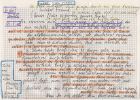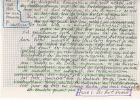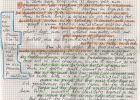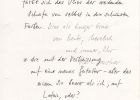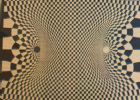, ( ) , On Vilém Flusser’s Idiosyncratic Use of Commas and Round Brackets
This essay explores a dimension of Vilém Flusser’s writing and thinking that has not received any attention so far: his idiosyncratic use of punctuation. Punctuation marks are more than just a way of structuring sentences. They can also be seen as gestures, as embodiments of specific mental attitudes. In this sense, Flusser’s frequent combination of round brackets included within commas articulates a fundamental tension in his thinking. These punctuation clusters are the very site where two contrary tendencies of his thinking meet and collide: the constant creative push forward and the continuous flow of the ongoing reflection, on the one hand, and the persistent urge to stray off from the main path through frequent associative eruptions on the other. It is the conflict between circles and lines, between the sprawl of tangential offshoots and the continuous attempt to impose linearity by chopping off the outgrowths, the tension between losing oneself in writing and the wish to keep in control. As Flusser calls it in “The Gesture of Writing”, it is the tenacious struggle between the ramifications of the ‛branching thought tree’ and the formal compulsion of the ‛Mesopotamian brick’. The essay also contains a detailed analysis of Flusser’s “The Gesture of Writing”, “Le geste d’écrire” and “O gesto de escrever” that shows how the use of this specific punctuation cluster evolves in the process of self-translation.
Vilém Flusser in Europa
This unpublished lecture reconstructs Vilém Flusser’s European impact from 1972 to 1998. It outlines the dual engagement framed by his distinction between “people of the word” and “people of the image,” beginning with the controversial, later enthusiastic embrace of his media philosophy in the German-speaking world to its scholarly analysis and the institutional establishment of his archive. The text examines Flusser’s publishing presence, his critical engagement with photographic work, and the development of his thinking towards philosophy as fiction.
Reading Flusser: An Abecedarium
This is a memoir of the writer's reading relationship to Flusser over roughly twenty years. It represents an effort to sift through a wide variety of tangled thoughts and associations to locate those topics and approaches characteristic of Flusser that remain most promising, that is, have potential to stimulate further research or new interest. Although it does characterise Flusser's work broadly as an ongoing engagement with alphabetic writing, its history, relationships with other communicative codes, identity with history as such, conflict with other codes, it does not draw any one overall conclusion. Flusser's ongoing impact is rather seen to emerge from the distinctive way the writing engages its reader -- questioning, challenging, often persuading. Reading Flusser includes observations about the specific effects of Flusser's writing on this reader in particular, about recent research that confirms or amplifies certain pivotal ideas in the broader framework of his thought -- particularly with respect to reading and writing, and some evidence of how his thinking enters into at least one reader's perceptions of contemporary events. The abecedarium, an archaic poetic form that gathers aspects of a topic around specific words or phrases and presents them in alphabetical order, seems suited to compressing a diversity of material into an orderly form.
A Forgotten Publication Project: Vilém Flusser’s “The Fairy Tale of Truth”
In the 1990s, the Bollmann Verlag planned to publish a complete edition of Vilém Flusser’s oeuvre. However, in the mid-nineties, due to financial difficulties, this plan had to be abandoned. In 1996, was published the last volume under the catchy title Kommunikologie. However, the material for another complete volume had already been assembled by Edith Flusser, Klaus Sander and Vera Schwamborn. The working title was Das Märchen von der Wahrheit. Glossen und Philosophiefiktionen (The Fairy Tale of Truth: Glosses and Philosophical Fictions). The first section contained a collection of twenty-seven philosophical fictions and the second nearly all the texts of the daily satirical column Posto Zero that were published from January 22 to April 12, 1972, shortly before Flusser’s return to Europe. For the publication project, Edith Flusser had translated practically all the Portuguese texts into German. The essay also discusses five of these previously unpublished texts in more detail.
L’image dilacérée par les calculs et les lettres / A imagem dilacerada por cálculos e letras.
This essay starts out from Flusser’s theory on the contrast between images and writing from the second narrative of creation in the Bible and proceeds in three successive movements: in the first movement of writing science and literature come together, in the second they are separated from each other and in the third a series of equations are constructed which allow researchers to predict the future. The action of the robot, although endowed with a powerful memory, is unable to fit into these movements and thus does not belong to the community of human beings.
Letters / Farben statt Formen / Coloration replacing formalisation / Farben verschlüsseln / Karl Gerstner / Vilém Flusser und die Farben
Vilém Flusser and Karl Gerstner got to know each other in February 1987 at the 2nd Latin American Seminar on Alternatives for the teaching of the history of science and technology. Their letter exchange covers a period of about two years (1987-1989). Flusser and Gerstner were united by an intellectual and emotional friendship, read each other’s works, and dedicated a very personal text to one another: “Karl Gerstner” and “Vilém Flusser und die Farben” published in 1992 after Flusser‘s death. Flusser wrote two other texts “Farben verschlüsseln“ and “Farben statt Formen“, together with its English version „Coloration replacing formalisation“ in early 1988, as a discussion proposal for Gerstner. He dedicated “Farben verschlüsseln“ to Gerstner and sent the text with a letter, dated March 4, 1988. While Flusser wrote all his texts with a typewriter, Gerstner’s letters are practically all handwritten and in some cases in colour. To emphasize this difference the letters have been published separately and in different formats: Flusser’s letters are PDF-files and Gerstner’s JPEG and JPG-files.
Leggere Flusser
Reading Flusser is not easy. One can easily get lost in his nomadic thought. Flusser’s writing must be understood as a game, with its own rules: the reader needs to play with those rules, by following or transgressing them. In this short essay, an excerpt from my doctoral dissertation, I try to detect some of Flusser’s habits as a writer that any reader should take into account. His anti-academicism, his plurilingualism, and his interdisciplinary approach demand extra work but can also be very fruitful.
Im Spielraum der Ironie. Wie Vilém Flusser über Design schrieb
Flusser’s writings on design are mainly characterized by an essayistic and ironic style. In my text, I highlight Flusser’s use of these two styles, since he considered that the conventional approaches of established discourses could not adequately address the existing realities, and their complexities. For Flusser, essays are phenomenological narrations concerned with arbitrary objects, in which the distinction between common and high culture becomes blurred. That explains why his writings on design and ethics, or on design and war, are described as being difficult to access, and are even provocative. But it is not only the content of Flusser’s essays that provokes. His ironic and parodist style of writing is used to make a caricature of the complacency of the design debates of his time, and to point to the evasive question of responsibility in design. He noted that ethical issues were never raised in relation to the designed objects, and thus he portrayed the design of common or mundane objects as being irresponsible, given that designers focused their attention solely on the object, rather than on the people who use it, or on the cultural contexts in which they were used. Accordingly, Flusser identified design as a tool by which culture betrayed itself. To emphasize this point, he employed images and exaggerations in his essays, which he called “karikaturale Vereinfachungen.” Flusser uses an elaborate etymological juggling of words and caricatures, which is key to his writings on design. I argue that without his etymological caricatures and the irony in his writings, Flusser could not have expressed his philosophy of design with precision.
Writing Philosophy. On Vilém Flusser’s Multilingual Dialogical Style
Flusser’s brilliant multilingual essayistic style is not only based on his practice of constant translation and retranslation. In his texts, he also makes frequent use of challenging metaphors, and even annoying comparisons, through an array of rhetorical devices including, etymologies, puns based on homophones (paronomasia), and polysemy, in order to draw the reader’s attention to the fundamental constructed ways of our looking at the world. His philosophical rhetoric of breaking up, multiplying, mixing, comparing, combining, linking and connecting is a strategy used to create novelty and surprise, that is, new information through recombination. Flusser’s philosophy operates on a meta-communicative level: language is a model, a network that captures meaning, given that all languages are artificial, and words do not primarily mean objects but other words of the same language or different languages. Languages are not primarily representational but interconnected systems of signs. Flusser calls our attention to the material side of the medium he is using, to the diversified opacity of the different languages he writes with. In sum, Flusser wants to achieve these different goals by having us embark with him as dialogical partners on an ironical journey.
Postscript
Flussers In the Universe of Technical Images was published in 1985, and was part of a surge of speculative, science-fiction like books and films about the information age that was slowly but surely emerging. Related titles include William Gibsons Neuromancer (1984), Jean Baudrillards Fatal Strategies (1983), Paul Virilio’s Negative Horizon (1984), and James Camerons The Terminator (1984). In the book Flusser tries to speculatively come up with a set of concepts that would allow him to enter into the Universe of technical images that is slowly but surely coming about in the 1980’s. In Chapter 11 he makes a fundamental shift in his writing strategy, and decides to go beyond the philosophical project of inventing new concepts for new situations, and actually enter the Universe of Technical Images in order to become the future ‘telematic man’. The next 10 chapters are among the best ever written by Flusser and describe what he sees and experiences as telematic philosopher in UTI. He makes a distinction between traditional or handmade images, technical or machinic images and dialogical, digital images. This last category is interactive, democratic, open, divine, as is the corresponding telematic man.
